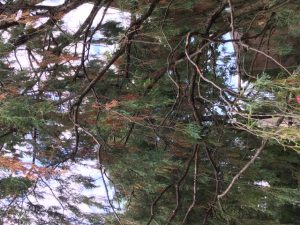
We have a Tolleson’s weeping Juniper, near our house, next to a patio. It is mature and surpasses the height of our 2 story home in our back garden. We have clay soil. For the past several years it has been losing the foliage – I have included some photos. I am not certain if it is relevant, but we have a Weeping Jade crabapple at the front of the house that has had a fungal attack for the past 3 years as well. This year I have sprayed both with a solution of of 3 Tbsps cider vinegar in a gallon of water. It seems to have stopped the browning for a bit. Perhaps, being that it is a mild anti fungal I should have sprayed more often – I erred on the side of caution. There is no gall – no reddish orange growth- just the dying foliage.
Is there anything I should be doing?
Regards,
The photo and your description of your Tolleson’s juniper indicate a tree that has reached its maximum age and height. The needle drop is natural decline, and there is really nothing that can be done to stop this natural aging process. You will have to make that hard choice of whether to retain this tree or to remove it.
Your crab apple likely has apple scab fungus, the most common fungal disease affecting apple trees, including crab apples. It should be treated in the spring with a commercial fungicide that contains lime sulphur, according to the directions on the label. Because this fungus overwinters on fallen diseased leaves, it is very important to clean up all fallen leaves from around your tree, and dispose of them in the garbage, rather than in your compost. Apple scab fungus is host-specific, i.e., the type of fungus that affects crab apples will affect only trees in the Malus family, and will have no effect on your juniper.
Here is a website that can help with a positive identification of this fungal disease: https://extension.umn.edu/plant-diseases/apple-scab

